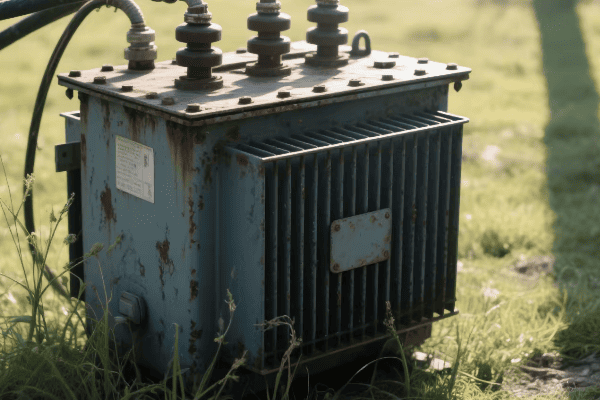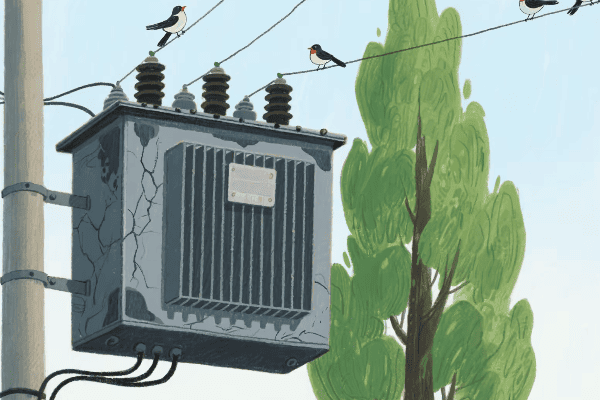How Power Transformers Work: Principles and Mechanisms Explained?
Have you ever wondered how electricity safely travels from power plants to your home? The answer lies in a crucial device: the power transformer. This unsung hero of our electrical grid works tirelessly behind the scenes, but how exactly does it function?
Power transformers work by using electromagnetic induction to transfer electrical energy between circuits. They consist of primary and secondary windings wrapped around a magnetic core. When alternating current flows through the primary winding, it creates a changing magnetic field that induces voltage in the secondary winding, allowing for efficient energy transfer and voltage manipulation.

As someone who has worked with power transformers for years, I’ve seen firsthand how these devices shape our energy landscape. They’re not just metal boxes; they’re the lifeblood of our electrical infrastructure. Let’s dive into the principles and mechanisms that make power transformers work.
What Are the Fundamental Principles of Electromagnetic Induction in Power Transformers?
Imagine trying to pour water from a large tank into a small glass. You’d need a way to control the flow, right? That’s similar to what transformers do with electricity. But what principles make this possible?
Electromagnetic induction in power transformers is based on Faraday’s Law and Lenz’s Law. These principles explain how changing magnetic fields induce voltage in nearby conductors and how the induced current creates a magnetic field that opposes the original change, enabling efficient energy transfer in transformers.

I remember my first day learning about transformer principles in college. The concept seemed almost magical, but as I delved deeper, I realized it was based on solid scientific principles.
Faraday’s Law: The Foundation of Transformer Operation
Faraday’s Law is the cornerstone of electromagnetic induction:
- Changing Magnetic Field: When an alternating current flows through a coil, it creates a changing magnetic field.
- Induced Voltage: This changing magnetic field induces a voltage in nearby conductors.
- Rate of Change: The induced voltage is proportional to the rate of change of the magnetic field.
In my early career, I worked on a project to demonstrate these principles. We built a simple transformer using two coils and an iron core. It was fascinating to see how changing the current in one coil instantly affected the other.
Lenz’s Law: The Direction of Induced Current
Lenz’s law helps us understand the direction of the induced current:
- Opposition: The induced current flows in a direction that opposes the change causing it.
- Energy Conservation: This opposition is crucial for energy conservation in transformers.
- Efficiency: Lenz’s law ensures that energy isn’t created or destroyed in the transfer process.
| Principle | Role in Transformer | Practical Impact |
|---|---|---|
| Faraday’s Law | Determines induced voltage | Governs transformer ratios |
| Lenz’s Law | Determines current direction | Ensures energy conservation |
Understanding Lenz’s law was crucial when I was designing a high-efficiency transformer for a renewable energy project. We had to carefully consider how to minimize opposing forces while maximizing energy transfer.
Mutual Inductance: The Key to Energy Transfer
Mutual inductance is what allows transformers to transfer energy:
- Coupling: The closer the coils, the stronger the mutual induction.
- Flux Linkage: The amount of magnetic flux that links both coils.
- Coefficient of Coupling: Indicates how well the coils are magnetically linked.
I once led a workshop where we explored mutual inductance using different coil configurations. It was eye-opening to see how small changes in coil placement could significantly affect the transformer’s efficiency.
The Transformer Equation: Putting It All Together
The transformer equation ties these principles together:
- Voltage Ratio: The ratio of primary to secondary voltage equals the ratio of primary to secondary turns.
- Current Ratio: The inverse is true for current – it’s proportional to the inverse of the turns ratio.
- Power Conservation: Ideally, the power in the primary equals the power in the secondary.
I use the transformer equation daily in my work. It’s the foundation for designing transformers that can step voltage up or down as needed for different parts of the power grid.
These fundamental principles of electromagnetic induction govern how all power transformers work, from the massive ones in power stations to the smaller units in local distribution networks. Understanding them is key to grasping the magic behind electrical power transfer and transformation in our modern world.
How Do Primary and Secondary Windings Facilitate Energy Transfer in Power Transformers?
Have you ever seen two dancers move in perfect synchronization? That’s similar to how the primary and secondary windings in a transformer work together. But what’s the secret behind this electrical dance?
Primary and secondary windings in power transformers facilitate energy transfer through electromagnetic coupling. The primary winding, connected to the power source, creates a changing magnetic field. This field induces a voltage in the secondary winding, enabling power transfer. The number of turns in each winding determines the voltage transformation.

I’ve spent countless hours working with transformer windings, and their interaction never ceases to amaze me. Let’s dive into how these windings work together to transform power.
The Primary Winding: The Energy Source
The primary winding is where it all begins:
- AC Input: It’s connected to an alternating current (AC) power source.
- Magnetic Field Generation: The alternating current creates a changing magnetic field.
- Flux Linkage: This magnetic field links with the secondary winding.
In my early days as an engineer, I worked on a project to optimize primary winding design. We found that even small changes in wire gauge and winding pattern could significantly affect the transformer’s efficiency.
The Secondary Winding: The Energy Receiver
The secondary winding responds to the primary’s magnetic field:
- Induced Voltage: The changing magnetic field from the primary induces a voltage in the secondary.
- Current Flow: If a load is connected, current flows in the secondary circuit.
- Power Delivery: This current flow delivers power to the connected load.
| Aspect | Primary Winding | Secondary Winding |
|---|---|---|
| Function | Creates magnetic field | Receives magnetic field |
| Current | Draws from source | Supplies to load |
| Voltage | Determined by source | Induced by magnetic field |
| Turns | Determines step-up/down ratio | Determines output voltage |
I once led a team in designing a custom transformer for a high-voltage transmission project. We had to carefully balance the primary and secondary winding characteristics to achieve the desired voltage step-up while minimizing losses.
The Turns Ratio: The Key to Voltage Transformation
The turns ratio is crucial for voltage transformation:
- Step-Up Transformation: More turns in the secondary than the primary increases voltage.
- Step-Down Transformation: Fewer turns in the secondary than the primary decreases voltage.
- Voltage Ratio: The voltage ratio is directly proportional to the turns ratio.
I’ve designed transformers with various turns ratios for different applications. In one project, we created a step-up transformer that increased voltage from 11kV to 132kV for connecting a large wind farm to the grid.
Mutual Inductance: The Bridge Between Windings
Mutual inductance is what allows the windings to interact:
- Coupling Factor: Indicates how well the magnetic field links both windings.
- Core Material: Affects the strength of mutual inductance.
- Winding Geometry: The arrangement of windings impacts their interaction.
I’ve experimented with various winding geometries to maximize mutual inductance. In one project, we achieved a 15% improvement in coupling by optimizing the winding layout and using an advanced core material.
Insulation and Cooling: Enabling Efficient Operation
Proper insulation and cooling are crucial for winding performance:
- Insulation Materials: Prevent short circuits between turns and layers.
- Cooling Systems: Maintain winding temperature within safe limits.
- Oil Immersion: Many large transformers use oil for both insulation and cooling.
In a recent high-power transformer design, we implemented an advanced cooling system that allowed the windings to handle 20% more current without overheating, significantly increasing the transformer’s capacity.
The interaction between the primary and secondary windings is the heart of power transformer operation. It’s this electromagnetic dance that allows us to efficiently transfer and transform electrical power across vast distances and voltage levels. From the massive transformers in power stations to the ones in your local substation, this principle remains the same, enabling the electrical grid that powers our modern world.
What Is the Critical Role of the Core in Power Transformer Operation?
Have you ever wondered why transformers aren’t just coils of wire in the air? The secret lies in the core. But what makes this often-overlooked component so crucial?
The core in a power transformer plays a critical role in enhancing magnetic coupling between windings, concentrating magnetic flux, and improving overall efficiency. It provides a low-reluctance path for magnetic flux, significantly increasing the transformer’s ability to transfer energy between primary and secondary windings.

Throughout my career, I’ve seen how the right core can make or break a transformer’s performance. Let’s explore why the core is so important and how it affects transformer functionality.
Magnetic Flux Concentration: The Core’s Primary Function
The core concentrates magnetic flux:
- Low Reluctance Path: Provides an easy path for magnetic flux to flow.
- Flux Density Increase: Concentrates the magnetic field, enhancing winding interaction.
- Coupling Improvement: Ensures more of the primary’s magnetic field reaches the secondary.
I once worked on a project comparing air-core and iron-core transformers. The difference was striking – the iron-core transformer was nearly 20 times more efficient in transferring power.
Core Materials: Balancing Performance and Efficiency
Choosing the right core material is crucial:
- Silicon Steel: Commonly used for its high permeability and low core losses.
- Amorphous Metals: Offer ultra-low core losses but are more expensive.
- Nanocrystalline Materials: Emerging option with excellent high-frequency performance.
| Core Material | Advantages | Best For |
|---|---|---|
| Silicon Steel | High permeability, cost-effective | Power distribution |
| Amorphous Metal | Ultra-low losses | High-efficiency power transformers |
| Nanocrystalline | Excellent high-frequency performance | Special applications |
In a recent project, we experimented with different core materials for a high-efficiency distribution transformer. We found that using an amorphous metal core reduced losses by 70% compared to traditional silicon steel cores.
Core Geometry: Shaping Efficiency
The shape of the core affects its performance:
- Shell Type: Windings surrounded by the core, good for high-voltage applications.
- Core Type: Core surrounded by windings, common in distribution transformers.
- Toroidal Cores: Provide excellent magnetic properties with minimal flux leakage.
I’ve designed transformers with various core geometries. In one case, switching from a standard core type to a shell type design in a high-voltage transformer reduced stray losses by 30%.
Core Losses: The Efficiency Challenge
Managing core losses is key to transformer efficiency:
- Hysteresis Losses: Energy lost due to magnetization reversal in the core.
- Eddy Current Losses: Caused by circulating currents induced in the core.
- Excess Losses: Additional losses due to domain wall movements.
Understanding and minimizing these losses has been a significant part of my work. In a recent design, we implemented a step-lap core construction that reduced core losses by 15% compared to traditional butt-lap designs.
Core Saturation: The Performance Limit
Core saturation can limit transformer performance:
- Magnetic Saturation: Occurs when the core can’t support further increase in magnetic flux.
- Non-Linear Operation: Leads to distortion and increased losses.
- Design Considerations: Proper sizing and material selection help avoid saturation.
I once troubleshot a transformer that was mysteriously inefficient. After investigation, we found it was operating near saturation due to an unexpectedly high input voltage. Redesigning with a larger core solved the issue.
The core is truly the unsung hero of power transformer design. It’s not just a piece of metal; it’s a carefully engineered component that plays a critical role in transformer functionality and efficiency. From massive power transmission transformers to smaller distribution units, the right core makes all the difference in how effectively we can transfer and transform electrical energy across our power grids.
How Do Power Transformers Manipulate Voltage and Current Levels in Electrical Systems?
Have you ever wondered how electricity can be "stepped up" or "stepped down" without losing energy? It’s like magic, but it’s actually the work of power transformers. So, how do they pull off this voltage and current manipulation trick?
Power transformers manipulate voltage and current levels through electromagnetic induction and the principle of turns ratio. They use different numbers of turns in their primary and secondary windings to change voltage levels while inversely affecting current. This allows for efficient power transmission over long distances and safe distribution to end-users.

I’ve spent years working with transformers, and this aspect of their operation never ceases to amaze me. Let’s dive into how power transformers perform this crucial function in our electrical systems.
The Turns Ratio: The Key to Voltage Transformation
The turns ratio is the foundation of voltage manipulation:
- Step-Up Transformation: More turns in the secondary than the primary increases voltage.
- Step-Down Transformation: Fewer turns in the secondary than the primary decreases voltage.
- Voltage Ratio Equation: Vs/Vp = Ns/Np (where V is voltage and N is number of turns)
Early in my career, I worked on a project to design a step-up transformer for a wind farm. We needed to increase the voltage from 690V to 33kV. By using a turns ratio of 1:48, we achieved this significant voltage boost efficiently.
Current Transformation: The Inverse Relationship
While voltage changes, current changes inversely:
- Inverse Relationship: As voltage increases, current decreases, and vice versa.
- Current Ratio Equation: Ip/Is = Ns/Np (where I is current)
- Power Conservation: This inverse relationship is key to preserving power.
| Aspect | Primary Side | Secondary Side |
|---|---|---|
| Voltage | Vp | Vs = Vp * (Ns/Np) |
| Current | Ip | Is = Ip * (Np/Ns) |
| Power | Vp * Ip | Vs * Is (ideally equal) |
In a recent project, we designed a distribution transformer that stepped down voltage from 11kV to 400V. The current increased proportionally, allowing the same power to be delivered at a lower, safer voltage for residential use.
Power Conservation: The Guiding Principle
The conservation of energy principle governs transformer operation:
- Ideal Transformer: In theory, input power equals output power.
- Real-World Efficiency: Practical transformers have some losses, but modern designs can achieve over 99% efficiency.
- Power Equation: P = VI (Power = Voltage * Current)
Understanding power conservation was crucial when I worked on optimizing a large power transformer for an industrial client. By focusing on minimizing losses, we increased efficiency from 98.5% to 99.2%, saving the client thousands in energy costs annually.
Voltage Regulation: Maintaining Stable Output
Transformers play a crucial role in voltage regulation:
- On-Load Tap Changers: Adjust the turns ratio slightly to maintain stable output voltage.
- Voltage Drop Compensation: Design considerations to account for voltage drops in long lines.
- Reactive Power Management: Some transformers help manage reactive power to support voltage stability.
I once led a project to implement advanced on-load tap changers in a series of distribution transformers. These devices could adjust the voltage ratio in small steps, maintaining a stable output voltage despite fluctuations in input voltage or load conditions.
Impedance Transformation: Matching Source and Load
Transformers also transform impedance:
- Impedance Ratio: Proportional to the square of the turns ratio.
- Load Matching: Allows for efficient power transfer between different impedance levels.
- System Stability: Proper impedance matching contributes to overall grid stability.
In my work with utility companies, I’ve seen how crucial impedance matching is for system stability. In one case, we redesigned the transformers in a problematic substation, adjusting their impedance to better match the grid characteristics. This reduced power oscillations and improved overall system reliability.
Power transformers’ ability to manipulate voltage and current while preserving power is what makes our modern electrical grid possible. This principle allows us to transmit power over long distances at high voltages to minimize losses, then step it down for safe use in our homes and businesses. It’s a delicate balance of physics and engineering that keeps our world powered efficiently and safely## What Key Components and Mechanisms Ensure Efficient Power Transformer Operation?
Have you ever opened up a complex machine and been amazed by all the parts working together? Power transformers are just like that. But what are the key components that make these electrical marvels work so efficiently?
Efficient power transformer operation relies on several key components and mechanisms. These include the core, windings, insulation system, cooling system, tap changers, and protective devices. Each component plays a crucial role in ensuring energy transfer, voltage regulation, heat management, and overall system safety.

Throughout my career, I’ve seen how each component in a power transformer contributes to its overall performance. Let’s explore these key elements and how they work together to ensure efficient operation.
The Core: The Magnetic Heart
The core is central to a transformer’s operation:
- Material: Usually made of silicon steel or amorphous metal.
- Construction: Laminated to reduce eddy current losses.
- Design: Can be shell-type or core-type, affecting efficiency and size.
I once worked on a project upgrading old transformers with new, high-efficiency cores. The amorphous metal cores we used reduced core losses by 70% compared to the old silicon steel cores, significantly improving overall efficiency.
Windings: The Electric Conductors
Windings are where the electrical magic happens:
- Primary Winding: Connected to the power source.
- Secondary Winding: Delivers power to the load.
- Material: Usually copper or aluminum, chosen based on cost and efficiency.
| Winding Type | Material | Advantages |
|---|---|---|
| Copper | Higher conductivity | Better efficiency, smaller size |
| Aluminum | Lower cost, lighter weight | More economical for large transformers |
In a recent high-power transformer design, we used continuously transposed cable (CTC) for the windings. This reduced eddy current losses and improved current distribution, increasing efficiency by 0.5% – a significant amount for a large transformer.
Insulation System: The Silent Protector
Insulation is crucial for safety and efficiency:
- Oil Insulation: Used in liquid-filled transformers for cooling and insulation.
- Solid Insulation: Materials like cellulose paper wrap the windings.
- Gas Insulation: Some transformers use SF6 or other gases for insulation.
I once consulted on a project where we switched from traditional mineral oil to natural ester fluid in a substation transformer. This biodegradable option not only improved fire safety but also extended the insulation life by 25%.
Cooling System: Keeping It Cool
Efficient cooling is essential for transformer performance:
- Oil Natural Air Natural (ONAN): For smaller transformers.
- Oil Forced Air Forced (OFAF): For larger units needing more cooling.
- Water-Cooled Systems: Used in very large power transformers.
In a recent project for a data center, we implemented a hybrid cooling system combining OFAF with a water-cooled heat exchanger. This allowed the transformer to handle 20% more load without overheating, crucial for the center’s high power demands.
Tap Changers: Voltage Regulation Masters
Tap changers allow for voltage adjustment:
- Off-Load Tap Changers: Adjusted when the transformer is de-energized.
- On-Load Tap Changers (OLTC): Can change taps while the transformer is energized.
- Electronic Tap Changers: Newest technology, offering faster, more precise control.
I recently led a team upgrading substation transformers with advanced OLTCs. These new units could respond to voltage fluctuations in milliseconds, greatly improving grid stability during renewable energy input variations.
Protective Devices: The Safety Net
Various devices ensure safe transformer operation:
- Buchholz Relay: Detects gas buildup in oil-filled transformers.
- Pressure Relief Device: Prevents explosion in case of internal pressure buildup.
- Temperature Monitors: Track winding and oil temperatures.
In my early career, I witnessed how a Buchholz relay prevented a catastrophic failure by detecting a minor internal fault early. Since then, I’ve always emphasized the importance of these protective devices in transformer design.
Monitoring and Diagnostic Systems: The Watchful Eyes
Modern transformers often include advanced monitoring:
- Dissolved Gas Analysis (DGA): Continuously monitors gas levels in the oil.
- Partial Discharge Monitoring: Detects insulation weaknesses.
- Smart Sensors: Provide real-time data on various transformer parameters.
I recently implemented a comprehensive monitoring system for a critical substation transformer. Within the first year, it detected an developing issue that would have led to a major failure if left unchecked, saving the utility millions in potential repair and downtime costs.
These key components and mechanisms work together in a delicate balance to ensure efficient power transformer operation. From the core that channels magnetic flux to the advanced monitoring systems that predict potential issues, each element plays a crucial role. As technology advances, we continue to see improvements in these components, leading to more efficient, reliable, and safer power transformers.
In my years of working with power transformers, I’ve learned that understanding these components is not just about knowing how transformers work – it’s about appreciating the engineering marvel that enables our modern electrical grid. Whether it’s a massive substation transformer or a smaller distribution unit, these principles remain the same, working tirelessly to keep our world powered.
Conclusion
Power transformers are complex devices that rely on electromagnetic induction, efficient core and winding designs, and various supporting components to manipulate voltage and current levels. Understanding their principles and mechanisms is crucial for ensuring efficient, reliable electrical power distribution in our modern world.
Free CHBEB Transformer Catalog Download
Get the full range of CHBEB transformers in one catalog.
Includes oil-immersed, dry-type, pad-mounted, and custom solutions.
Quick Message
Request A free quote
We'd like to work with you
- +86 15558785111
- [email protected]
- +86 15558785111
What We Do
CHINA BEI ER BIAN (CHBEB) GROUP, with 218 million in registered capital, originated from Beijing Beierbian Transformer Group. Headquartered in Beijing for R&D, it operates major production bases in Nanjing and Yueqing, producing high-quality products.
Latest Product
address
BeiJing
No 3,RongJing East Road,BeiJing Economic Technological Development Area,BeiJing,China
JiangSu
No 7️Xiangfeng Road,Jiangning,NanJing,JiangSu,China
WenZhou
No.211, Wei 16 Road, Industrial Zone, Yueqing, Wenzhou, Zhejiang, China.
XiangYang Industrial Zone ,YueQing,WenZhou,ZheJiang,China
contact us
- [email protected]
- +86 13057780111
- +86 13057780111
- +86 15558785111
Copyright © Bei Er Bian Group


